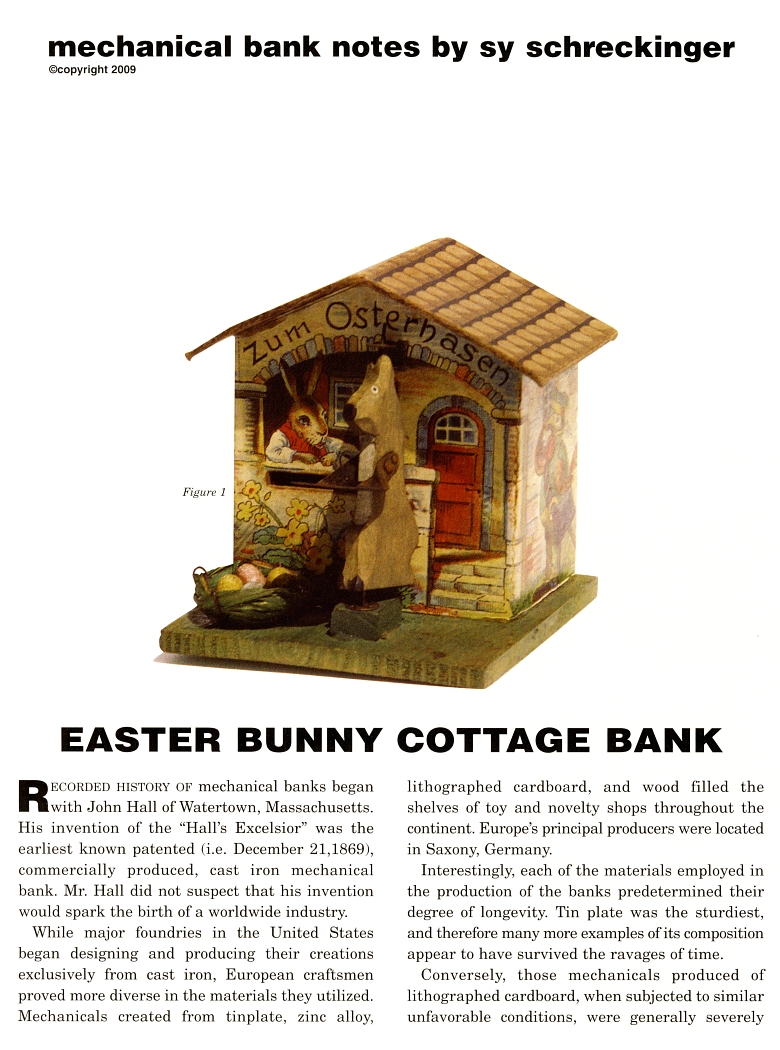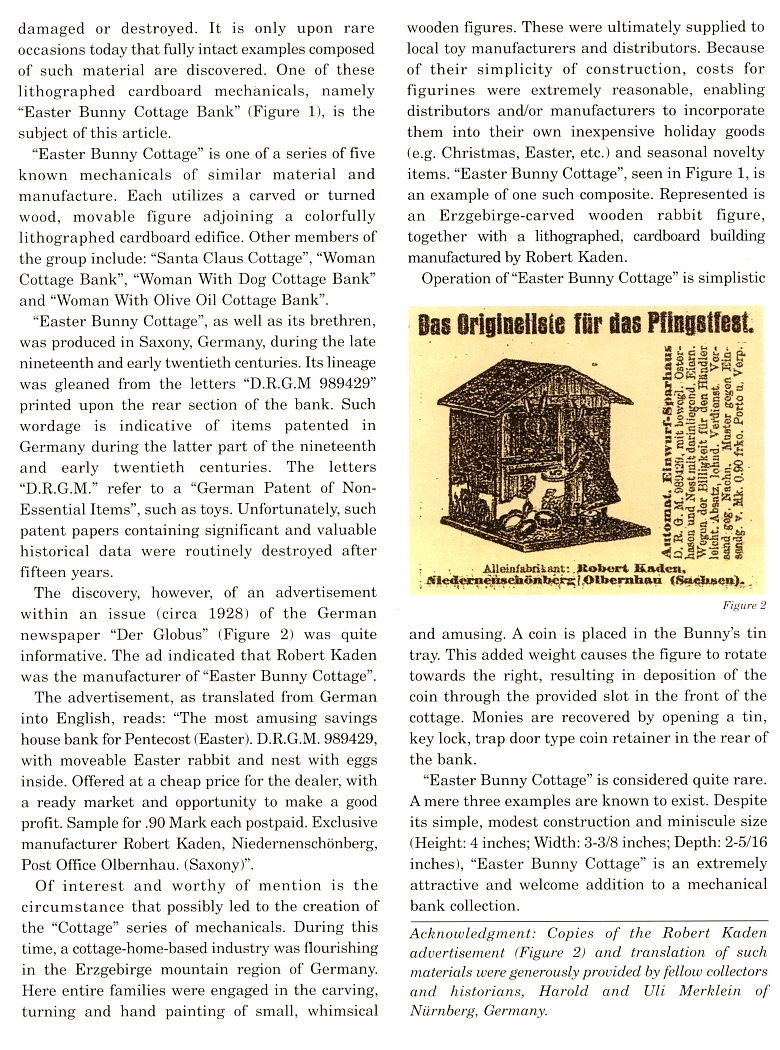|
Easter Bunny Cottage
Bank
by Sy Schreckinger – ANTIQUE TOY WORLD Magazine – May, 2009
Recorded history of mechanical banks began with
John Hall of Watertown, Massachusetts. His invention of the "Hall's
Excelsior" was the earliest known patented (i.e. December 21,1869),
commercially produced, cast iron mechanical bank. Mr. Hall did not suspect
that his invention would spark the birth of a worldwide industry.
While major foundries in the United States began designing and
producing their creations exclusively from cast iron, European craftsmen
proved more diverse in the materials they utilized. Mechanicals created
from tinplate, zinc alloy, lithographed cardboard, and wood filled the
shelves of toy and novelty shops throughout the continent. Europe's
principal producers were located in Saxony, Germany.
Interestingly, each of the materials employed in the production of
the banks predetermined their degree of longevity. Tin plate was the
sturdiest, and therefore many more examples of its composition appear to
have survived the ravages of time.
Conversely, those mechanicals produced of lithographed cardboard,
when subjected to similar unfavorable conditions, were generally severely
damaged or destroyed. It is only upon rare occasions today that fully
intact examples composed of such material are discovered. One of these
lithographed cardboard mechanicals, namely "Easter Bunny Cottage Bank"
(Figure 1), is the subject of this article.
"Easter Bunny Cottage" is one of a series of five known mechanicals
of similar material and manufacture. Each utilizes a carved or turned
wood, movable figure adjoining a colorfully lithographed cardboard
edifice. Other members of the group include: "Santa Claus Cottage", "Woman
Cottage Bank", "Woman With Dog Cottage Bank" and "Woman With Olive Oil
Cottage Bank".
"Easter Bunny Cottage", as well as its brethren, was produced in
Saxony, Germany, during the late nineteenth and early twentieth centuries.
Its lineage was gleaned from the letters "D.R.G.M 989429" printed upon the
rear section of the bank. Such wordage is indicative of items patented in
Germany during the latter part of the nineteenth and early twentieth
centuries. The letters "D.R.G.M." refer to a "German Patent of Non-Essential Items", such as toys. Unfortunately, such patent papers
containing significant and valuable historical data were routinely
destroyed after fifteen years.
The discovery, however, of an advertisement within an issue (circa
1928) of the German newspaper "Der Globus" (Figure 2) was quite
informative. The ad indicated that Robert Kaden was the manufacturer of
"Easter Bunny Cottage".
The advertisement, as translated from German into English, reads:
"The most amusing savings house bank for Pentecost (Easter). D.R.G.M.
989429, with moveable Easter rabbit and nest with eggs inside. Offered at
a cheap price for the dealer, with a ready market and opportunity to make
a good profit. Sample for .90 Mark each postpaid. Exclusive manufacturer
Robert Kaden, Niedernenschonberg, Post Office Olbernhau. (Saxony)".
Of interest and worthy of mention is the circumstance that possibly
led to the creation of the "Cottage" series of mechanicals. During this
time, a cottage-home-based industry was flourishing in the Erzgebirge
mountain region of Germany. Here entire families were engaged in the
carving, turning and hand painting of small, whimsical wooden figures.
These were ultimately supplied to local toy manufacturers and
distributors. Because of their simplicity of construction, costs for
figurines were extremely reasonable, enabling distributors and/or
manufacturers to incorporate them into their own inexpensive holiday goods
(e.g. Christmas, Easter, etc.) and seasonal novelty items. "Easter Bunny
Cottage", seen in Figure 1, is an example of one such composite.
Represented is an Erzgebirge-carved wooden rabbit figure, together with a
lithographed, cardboard building manufactured by Robert Kaden.
Operation of "Easter Bunny Cottage" is simplistic and amusing. A coin
is placed in the Bunny's tin tray. This added weight causes the figure to
rotate towards the right, resulting in deposition of the coin through the
provided slot in the front of the cottage. Monies are recovered by opening
a tin, key lock, trap door type coin retainer in the rear of the bank.
"Easter Bunny Cottage" is considered quite rare. A mere three
examples are known to exist. Despite its simple, modest construction and
miniscule size (Height: 4 inches; Width: 3-3/8 inches; Depth: 2-5/16
inches), "Easter Bunny Cottage" is an extremely attractive and welcome
addition to a mechanical bank collection.
Acknowledgment: Copies of the Robert Kaden advertisement (Figure 2)
and translation of such materials were generously provided by fellow
collectors and historians, Harold and Uli Merklein of Nurnberg, Germany.
|


